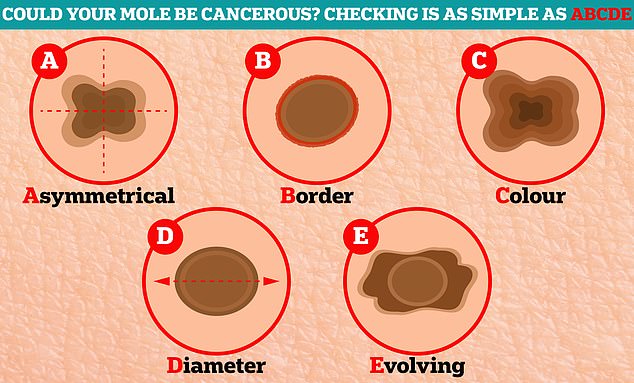I discovered 20 tumors in my body after using a popular beauty product and was diagnosed with stage 4 melanoma after a mole I removed turned into cancer
A 26-year-old woman credits a trendy beauty routine with saving her life after she discovered a lump on her neck that turned out to be stage 4 melanoma.
Helen Bailey, a real estate agent from Alabama, was using a spatula-like tool to reduce inflammation in her face with a technique called gua sha when she rolled the device over a lump in her neck.
She immediately called her doctor.
It grew quickly and developed into a plum about the size of a gumball. Little did she know, the lump was a warning sign of the two dozen tumors that had invaded her body, all arising from a cancerous mole on her back that she had removed years ago.
But now it was back, and more aggressive than ever.
Ms Bailey, now 28, was diagnosed with stage four metastatic melanoma, an aggressive form of skin cancer with a survival rate of just 22 per cent.
To treat her melanoma, doctors sent Helen Bailey multiple surgeries to cut out tumors and gave her immunotherapy, a rapidly developing field of cancer medicine.

Mrs. Bailey’s cancer spread from her skin to her lymph nodes, where it then spread to the rest of her body. She said she had a tumor on most of her organs.
What followed her diagnosis in the spring of 2022 were months of treatments that left her with 104-degree fevers almost every day, uncontrollable tremors, 20-pound weight loss, rashes, loss of appetite, chronic pain and internal bleeding.
Ms Bailey wrote on her TikTok: ‘If I hadn’t gone to the doctor when I did, I definitely wouldn’t be here now.’
Now she urges young people to never ignore new moles and make annual appointments with a dermatologist.
As well as raising awareness about skin cancer, Ms Bailey urged her hundreds of thousands of TikTok viewers to wear sunscreen every day and avoid overexposure to the sun.
She explained in a video: ‘I didn’t know much about skin cancer or anything… I feel like the more people know, the more lives we can save.”
Melanoma is a disease of the cells that give the skin its color, called melanocytes. When the melanocyte’s DNA becomes damaged – for example due to excessive sun exposure or severe sunburn – it can mutate, evolve into cancer and begin to multiply rapidly.
Thirty percent of melanoma cases start in moles, but there is a small percentage of cases that cannot be traced to one location. It is possible, write regular doctors at the Cleveland Clinic, that the disease begins in undamaged areas of the skin.
Seven years before she was diagnosed, Ms Bailey had a cancerous mole removed from her back. Although removing the growth often helps prevent the development of further cancer, sometimes not all of the cancerous tissue is removed and it continues to spread unnoticed.
In Miss Bailey’s case, the cancer spread from her skin to her lymph nodes, she said on TikTok. From there it used her lymphatic system to spread throughout her body.

Seven years before she was diagnosed with cancer from this lump, Mrs. Bailey had a cancerous mole removed by a dermatologist.

Miss Bailey was treated with surgery and immunotherapy. She is now in remission.
A stage 4 diagnosis of melanoma indicates that the cancer has spread from its site of origin to distant parts of the body, such as the brain, liver, or lungs.
It is estimated that one in 50 Americans will be diagnosed with melanoma at some point in their lives, and by 2024, approximately 100,640 people are expected to be diagnosed with the disease. Melanoma Research Alliance.
The average age at diagnosis is 63 years.
However, melanoma is one of the most common cancers in people under the age of 30 and has increased ‘dramatically’ over the past thirty years. according to Cleveland Clinic.
The clinic said this could be because the ozone layer has thinned in areas due to climate change, bringing in more UV rays, which mutate the skin.
Only a quarter of people diagnosed with stage 4 melanoma live five years after their diagnosis Melanoma Research Alliance.
Mrs Bailey was told her chances of surviving the next year were ‘pretty slim’. she shared on Instagram.
In her case, the melanoma in her birthmark grew into twenty tumors that had settled in or on most organs of her body.
Doctors operated on her ‘many’ times to remove the tumors and she was treated with immunotherapy – a newly developed treatment that edits cells from a patient’s body to attack the cancer.
Her diagnosis is part of the reason why she is passionate about spreading awareness today.
“Early detection through regular skin checks and prompt medical attention are crucial for a better prognosis,” she said.
It is recommended to have a full body skin check by a dermatologist once a year so that doctors can identify and check any suspicious moles, or test them to see if they are cancerous.

One of the most common tools that dermatologists tell their patients to use when detecting skin cancer are called the ABCDEs.
A stands for asymmetry: is the birthmark completely symmetrical? Melanomas are often uneven and have halves of different sizes and shapes.
B is for boundary: Does the mole have clear boundaries? Melanomas more often have irregular or jagged edges.
C is for color: is the color the same everywhere on the birthmark? Melanomas are more likely to have multiple shades.
D is for diameter: How big is the mole? Usually they should be the size of the end of a pencil and melanomas are usually larger.
Finally, E stands for evolve: has the mole changed over time? Most benign moles remain the same year after year, but melanomas can increase in size and shape and change color over time.
Despite her initially bleak prognosis, Ms Bailey was told in February 2023 that her doctors could no longer detect signs of cancer in her body.
She still gets regular scans every three months to stay vigilant. For the time being, she will continue the treatment to ensure that all the cancer is gone and stays away. I still can’t believe I was able to get to this point.”
